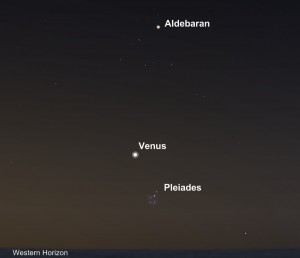From now until early October 2010, expect to hear the occassional report of a UFO being visible above the Western horizon in the early evening twilight. Reports will come in about a bright stationary object that “..just sits there and changes colour..” to quote one report I can remember.
That will be the planet Venus which is now positioned in it’s orbit such that we see it in the evening twilight until October. The planet appears as a brilliant white star to the unaided eye. However when it starts to set, the light from the planet is ‘bent’ or distorted by the Earth’s atmosphere so that we see separate colours. I always relate it to playing with a crystal in the Sun and you get the different colours of the rainbow flashing everywhere.
From a casual skywatchers point of view, now is a good time to use Venus as a kind of a celestial signpost to find two open clusters of stars. Open clusters are interesting because they are made up of relatively young groups of stars who are starting to go their separate ways after being born. Our Sun used to be a member of one such group before it and we went our own way a long time ago.
Look below Venus in the evening twilight tonight to see the Pleiades open cluster. This is more commonly known as the Seven Sisters. To find the other open cluster, simply look above Venus for the star Aldebaran. You will see it is part of a v group of stars (lying on their side from our orientation). That is the Hyades open cluster.

Thanks for your info on Venus!
I was wondering whether Venus get this big/bright in the sky every winter? or is it just particularly close this year? Also, is there a particular time when it is at its brightest? – I haven’t been able to find any specific info on this yet.
ThanX
Rhubarb,
Thanks for your question.
Venus is at it’s peak brightness when it is near it’s maximum elongation in its orbit from the Sun. Wikipedia as a good diagram showing what I mean by elongation here: http://en.wikipedia.org/wiki/Elongation_(astronomy)
Venus can either reach maximum elongation in the morning or evening sky. This year Venus reaches maximum elongation in the evening sky on Friday August 20th 2010.
My copy of Astronomy 2010 (http://www.quasarastronomy.com.au), says that Venus reaches its greatest elongated extent on 24 September 2010.
When I watch Venus this time of year it appears to be jumping wildly about. What causes this illusion?
Donna,
Firstly nice to hear from you.
I need to ask a question first. You mention you are looking at Venus. I assume you are an early morning riser as Venus is currently visible in the pre-dawn sky (look above the Eastern horizon)?
That asked, the reason why Venus appears to jump around wildly has to do with the Earth’s atmosphere. Essentially, the lower Venus is above the horizon, the more atmosphere that the light from Venus has to travel through to reach your eyes. It is sort of looking like looking though a dirty window which distorts the image. In real life it is the Earth’s atmosphere acting like a weak lens which distorts the how we see Venus. However, unlike a window, the Earth’s atmosphere has wind. This means that the wind helps to bend or break apart the image (as well as the fact that Venus appears to be moving – meaning that the light we see from it travels through different layers while we are watching. And that is the source of the ‘jumping’ you are seeing.
Regards,
Paul Floyd.
You can easily see why the Romans gave it is name, it is always an impressive and beautiful object in the night sky.